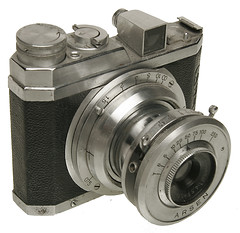Arsen
The Arsen (アルゼン) is a Japanese camera taking 4×4cm exposures on 127 film, based on the 3×4cm Gelto and made between 1938 and 1944 by the same company Tōa Kōki.[1] That company was perhaps called Takahashi Kōgaku at an earlier period, and this certainly explains why the camera is attributed to Takahashi in most recent sources.[2] It was sold by Ars, the publisher of the magazine Ars Camera, and it was probably named Arsen for that reason.
Contents
Description
Main body
The Arsen is extremely similar to the prewar Gelto, except for the picture format. Both cameras are inspired by the Picny, itself a copy of the German Wirgin Gewirette. The body is made of die-cast metal and has sharp edges. The name ARSEN is embossed in the front leather covering at the front. The lens and shutter assembly is collapsible and is mounted on a focusing helix. The tubular optical finder is offset to the left, as seen by the photographer, and there is an accessory shoe further to the left.
Unlike the Gelto, the Arsen has an auto-stop advance mechanism contained in a small casing on the right, under the advance knob, with a small round window for an exposure counter. The auto-stop feature was necessary because the paper backing of 127 film was not marked for 4×4cm pictures at the time.
The top plate is removable for film loading, in the same spirit as the bottom loading of the Leica screw models. It is locked in place by a key placed above the top casing. There is a single red window in the back, used to set the position of the first exposure, instead of the two red windows of the Gelto. It is offset to the left and is protected by a horizontally sliding cover.
Under the camera, the tripod thread is offset towards the advance side, and the serial number is engraved on a round flange on the opposite side.
Lens and shutter
The shutter was made by Tōa Kōki.[3] It gives T, B, 5–250 speeds, and it has two levers at the top, one for cocking and another for tripping. It is exactly the same as that of the prewar and wartime Gelto, but for the name ARSEN engraved at the botom.
The lens is a three-element Anastigmat Grimmel 50mm or 5.0cm f/4.5, made by Fujita Kōgaku Kikai.[4] The focusing helix goes down to 0.5m and the aperture scale goes from 4.5 to 32.
The original lens cap is silver finished; it is normally attached to the focus tab by a chain, and has the name Arsen engraved in black.
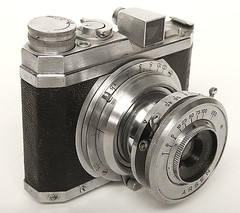 
|
| Arsen no.27609, Anastigmat Grimmel 5.0cm f/4.5 no.28690, black bezel. image by Rick Soloway (Image rights) |
Accessory rangefinder
An external rangefinder was offered as an accessory for the Arsen. It was inspired by the Leitz rangefinder of the Leica Standard, albeit with a shorter base. It has a nickel finish overall. There are two round flanges at the ends and a setting wheel on the rear, going down to 0.5m. The name "ARSEN" is engraved at the top (between quotes), and a serial number is engraved at the rear.[5] This model is similar to the first type of Gelto rangefinder.
A different rangefinder was perhaps offered later, similar to the second type of Gelto rangefinder with rounded rectangular ends. (This advertisement by Matsuzaki Shashinki-ten published in 1941 and reproduced in Nostalgic Camera shows the new type of rangefinder, and lists two versions, for the Arsen and for the Gelto, both at ¥16.50.)
Original documents
The Arsen was first announced and advertised in Japanese photography magazines dated March 1938.[6] The announcement published that month in Asahi Camera, reproduced below, shows a picture of the camera in black finish, with the advance casing, viewfinder and lens barrel in chrome or nickel finish.[7] No other document is known to show this black variant, and no actual example has been found either. Ιn the document, the camera is announced for ¥88, and no company name is indicated.

|
Announcement in Asahi Camera March 1938, showing a black Arsen. scanned by rebollo fr
|
Because the camera was distributed by the Ars publishing company, it was mainly advertised in the affiliated magazines Ars Camera and Camera Club and their wartime successors Shashin Bunka and Shashin Kagaku. The January 1939 issue of Asahi Camera nonetheless contains a two-page advertisement by Ars, reproduced below, offering the camera at an unchanged price and the accessory rangefinder for ¥16.50.[8] It shows a picture of a regular nickel-finished camera with lens no.1426. A very similar advertisement appeared in the July 1940 issue of Camera Club, but the price of the camera was raised to ¥95.[9]
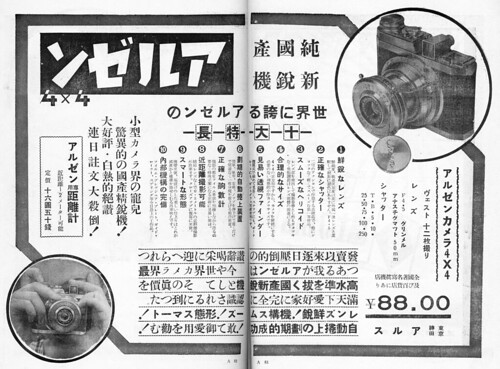
|
|
Advertisement in Asahi Camera January 1939. scanned by rebollo fr
|
In the official list of set prices compiled in October 1940 and published in January 1941, the camera appears for ¥95 with no further detail.[10] In the official government inquiry on Japanese camera production, compiled in April 1943, the Arsen is mentioned as made by Tōa Kōki Seisakusho and distributed by Ars[11]
The camera was available throughout the war. The advertisements reproduced below were placed in Shashin Kagaku between January and July 1944.[12] The only company name is Ars, and the picture is the same as in the earlier advertisements. The price of the body was raised to ¥125 (January and February), then ¥153.50 (July). Three types of accessories are listed: a hood for ¥3.50, a case for ¥7.82 and a rangefinder for ¥24.30. Similar advertisements are reported until the November–December issue of the magazine.
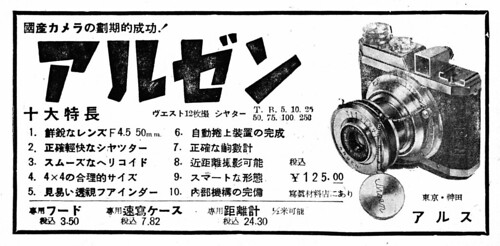
|
| January and February 1944 |
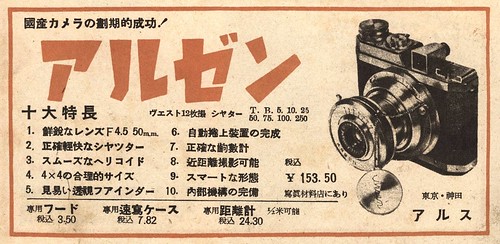
|
| July 1944 |
| Advertisements in Shashin Kagaku. (Image rights) |
Actual examples
Serial numbers for the Arsen bodies and lenses were apparently mixed with those for the Gelto. Body numbers are confirmed from 2891 to 28937, in a sequence that perhaps started at 1000. Lens numbers are known from 1426 (in the advertisements) up to 29682. This would give a total of about 28,000 Gelto and Arsen cameras produced until 1945.
Variations are known in the finish of the lens bezel and in the engraving of the focal length. The lens bezel is usually black with white markings, but a few cameras have a nickel bezel instead, with black markings. This minor variation was apparently applied twice during the production run, once around lens no.15000, and again around lens no.23000. Independently from this, the engraving of the focal length switched from 50mm to 5.0cm around lens no.20000.
Rangefinder conversions
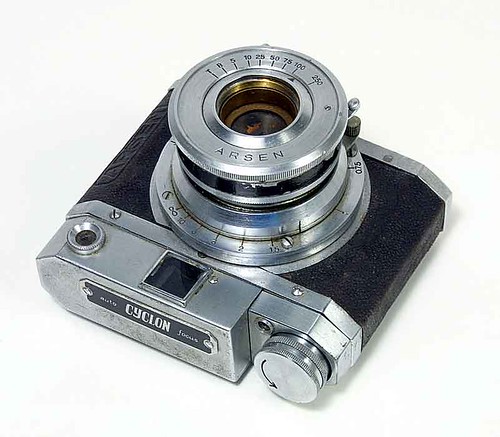
|
| Arsen, Cyclon rangefinder conversion. The lens elements are missing. Picture courtesy of Pacific Rim Camera. (Image rights) |
The Cyclon coupled rangefinder conversion offered in 1943 and 1944 for the Gelto was also available for the Arsen.[13] Various surviving examples have been observed, with the auto CYCLON focus nameplate screwed above the top housing. The conversion is described in detail in this section of the Gelto page. It is not known if the earlier conversion with separate range and viewfinder, called Suzuki coupled device, was also offered for this camera.
Notes
- ↑ Made by Tōa Kōki: "Kokusan shashinki no genjōchōsa" ("Inquiry into Japanese cameras"), item 138.
- ↑ Sources attributing the Arsen to Takahashi: Kokusan kamera no rekishi, p.334, Sugiyama, item 3004, McKeown, p.912. This page at Asacame says that the Arsen was made by the same Takahashi company as the Gelto, and Sugiyama, items 3017–8, attributes the early Gelto models up to 1938 to Takahashi.
- ↑ "Kokusan shashinki no genjōchōsa" ("Inquiry into Japanese cameras"), shutter item 18-P-28.
- ↑ "Kokusan shashinki no genjōchōsa" ("Inquiry into Japanese cameras"), lens item Jc6.
- ↑ Examples pictured in Fujishima, p.120 of Kurashikku Kamera Senka no.38, and observed in an online auction.
- ↑ Kokusan kamera no rekishi, p.334.
- ↑ Column in Asahi Camera March 1938, p.470.
- ↑ Advertisement in Asahi Camera January 1939, pp.A81–2.
- ↑ Advertisement reproduced in Kokusan kamera no rekishi, p.58.
- ↑ "Kokusan shashinki no kōtei kakaku", type 1, section 9.
- ↑ "Kokusan shashinki no genjōchōsa" ("Inquiry into Japanese cameras"), item 138.
- ↑ Advertisements in Shashin Kagaku January 1944, p.73, February 1944, p.65, and July 1944, p.3. A similar advertisement, from Shashin Kagaku March 1944, was formerly reproduced at Gochamaze (archived).
- ↑ Advertisements dated July 1943 and May 1944 reproduced in Kokusan kamera no rekishi, pp.111–2.
Bibliography
Original documents
- Asahi Camera March 1938. "Atarashii kikai to zairyō" (新しい機械と材料, New equipment and machinery). P.470.
- Asahi Camera Advertisement by Ars in January 1939, pp.A81–2.
- Shashin Kagaku Advertisements by Ars:
- January 1944, p.73;
- February 1944, p.65;
- July 1944, p.3.
Modern sources
- Asahi Camera (アサヒカメラ) editorial staff. Shōwa 10–40nen kōkoku ni miru kokusan kamera no rekishi (昭和10–40年広告にみる国産カメラの歴史, Japanese camera history as seen in advertisements, 1935–1965). Tokyo: Asahi Shinbunsha, 1994. ISBN 4-02-330312-7. Item 10.
- Fujishima Kōichi (藤島広一). "Kyorikei 2 - Nihon-sei" (距離計・2・日本製, Rangefinders 2: Made in Japan). Kamera Rebyū: Kurashikku Kamera Senka (カメラレビュー クラシックカメラ専科) / Camera Review: All about Historical Cameras no.38, June 1996. ISBN 4-257-13003-2. Purakuchika maunto (プラクチカマウント, special issue on the Praktica mount). Pp.118–23. (On the Arsen rangefinder.)
- "Kokusan shashinki no genjōchōsa" (国産写真機ノ現状調査, Inquiry into Japanese cameras), listing Japanese camera production as of April 1943. Reproduced in Supuringu kamera de ikou: Zen 69 kishu no shōkai to tsukaikata (スプリングカメラでいこう: 全69機種の紹介と使い方, Let's try spring cameras: Presentation and use of 69 machines). Tokyo: Shashinkogyo Syuppan-sha, 2004. ISBN 4-87956-072-3. Pp.180–7. Item 148.
- "Kokusan shashinki no kōtei kakaku" (国産写真機の公定価格, Set prices of the Japanese cameras), listing Japanese camera production as of October 25, 1940 and setting the retail prices from December 10, 1940. Published in Asahi Camera January 1941 and reproduced in Shōwa 10—40nen kōkoku ni miru kokusan kamera no rekishi (昭和10〜40年広告にみる国産カメラの歴史, Japanese camera history as seen in advertisements, 1935—1965). Tokyo: Asahi Shinbunsha, 1994. ISBN 4-02-330312-7. Pp.108—9. Type 1, section 9.
- McKeown, James M. and Joan C. McKeown's Price Guide to Antique and Classic Cameras, 12th Edition, 2005-2006. USA, Centennial Photo Service, 2004. ISBN 0-931838-40-1 (hardcover). ISBN 0-931838-41-X (softcover). P.912.
- Sugiyama, Kōichi (杉山浩一); Naoi, Hiroaki (直井浩明); Bullock, John R. The Collector's Guide to Japanese Cameras. 国産カメラ図鑑 (Kokusan kamera zukan). Tokyo: Asahi Sonorama, 1985. ISBN 4-257-03187-5. Item 3004.
Links
General links
In English:
- Arsen, serial no. 8385: lot 85 of the March 25, 2006 Photographica and Film auction by Auction Team Breker
- Arsen, serial no. 22389, sold at the nineteenth Westlicht Photographica Auction, on 28 May 2011.
In Japanese:
- Arsen in Ranzōsha's camera pages
- Pages at Asacame:
- Arsen in the A-Z 127 film cameras
- Arsen in the Gelto page
- Arsen in a page of the AJCC website
- Arsen and more pictures in Miyazawa Noriyuki's camera site
- Arsen in the second page of the Yamada Camera Museum
Original documents
In Japanese:
- Advertisement for the Gelto auxiliary rangefinder published in 1941 and reproduced in Nostalgic Camera, a page by Toshio Inamura
